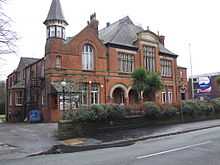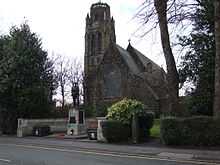Heaton Moor
| Heaton Moor | |
 Viewed from the south |
|
 Heaton Moor | |
| Population | (2001 Census) |
|---|---|
| OS grid reference | SJ895937 |
| Metropolitan borough | Stockport |
| Metropolitan county | Greater Manchester |
| Region | North West |
| Country | England |
| Sovereign state | United Kingdom |
| Post town | STOCKPORT |
| Postcode district | SK4 |
| Dialling code | 0161 |
| Police | Greater Manchester |
| Fire | Greater Manchester |
| Ambulance | North West |
| EU Parliament | North West England |
| UK Parliament | Stockport |
| |

Heaton Moor is a suburb located in Stockport, Greater Manchester, in North West England. It is one of the Four Heatons and borders onto Heaton Chapel, Heaton Norris and Heaton Mersey. Heaton Moor is characterised by the affluent Victorian housing built between 1852 and 1892 along tree lined streets which follow the field patterns of a former agricultural economy.[1]
Heaton Moor is affluent. During the Victorian era, Heaton Moor had an equal residential status to Alderley Edge and Bowdon.[2] Today this moneyed reputation continues as the SK4 postcode is typically characterized by high disposable incomes.[3] The estimated household weekly income for Heaton Moor in 2001 was significantly above the average for Greater Manchester.[4]
Governance
Heaton Moor is in the Metropolitan Borough of Stockport, mainly within the Heatons North ward. It was originally in the township of Heaton Norris, in the Salford hundred of Lancashire. Following the 1834 Poor Law Amendment Act it was administered by Heaton Norris Local Board as part of the Stockport Poor Law Union. In 1913, Heaton Moor, as part of Heaton Norris was absorbed into Stockport, in the county of Cheshire.[1]
Geography
The land in Heaton Moor is predominantly flat with no rivers or streams. The soil is black and fertile as expected from land that was previously peat moor. Heaton Moor has little public open space with the exception of Heaton Moor Park and Thornfield Park, but because of its tree lined roads and the building line set well back from the street, it gives the impression of having more space, and a Victorian business class style.[2]
Today the conservation area including the Clifton Road and Mauldeth Road streets make up what is locally known as "Millionaire's Row".[5]
History




Before the opening of the railway, Heaton Moor was agricultural land in Heaton Norris. The land supported pigs cattle and cereal. Heaton Norris was part of the Manchester barony of the Grelley family, but between 1162 and 1180 it belonged to William le Norreys.[1] In the early 13th century, Heaton Norris was a sub manor of Manchester, it encompassed all of the Four Heatons. It was escheated (i.e. reverted) to the manor of Manchester around 1280. In 1322, there were 32 dwellings suggesting a population of 150, the ten freeholders of the escheated manor had the right to graze on common pasture and to cut wood.[6] Evidence of this pre railway existence can be seen from the name Shaw Farm, Shaw Fold farm, and the road pattern Heaton Moor Lane, Shaw Lane, Shaw Fold Lane, Pin Fold, Green Lane. Parsonage Road and Cranbourne Grove follow the lines of ancient tracks.[1]
The opening of Heaton Chapel railway station marked a turning point in development of the area. Land was acquired, and streets were planned. The houses and new buildings along Heaton Moor Road were of a grandiose scale with generous gardens. They are set back from the road, and have imposing stone gate posts. The new residential roads such as Broomfield Road, Derby Road, and Peel Moat Road which were built when agricultural land was acquired, have the same characteristics. The building and infilling continued into the Edwardian era. There were a wide range of sporting facilities, such as crown green bowling, tennis and golf. A substantial terrace of shops was built on Heaton Moor Road,with glass and cast iron awnings. Intellectual life was provided for when the Reform Club was built in 1886 by Alfred Darbyshire.
The Savoy Cinema opened 1923, built in the Baroque Style in red brick with white terracota dressings.[1] The Savoy Cinema had announced its closure due to low audiences.[7] This caused an uproar amongst locals, especially when it was announced it could be replaced by a Varsity bar - though, much of the uproar was concerned around the owners of Varsity, the Barracuda Group.[8] A campaign entitled 'Save Our Savoy' was launched. Although the plans for the Varsity were thrown out,[9] the cinema is still on the market on a "to let" basis through Roger Hannah & Co but is still open for business.
A second hub was built around Thornfield, the former town hall at Moor Top. The main thoroughfare is now home to wine bars, boutiques, florists and upmarket restaurants.
Mauldeth Hall

Mauldeth Hall is a large Greek Revival villa, built in 1832-60, for Joseph Chessborough Dyer; extended in 1880-82 by Charles Heathcote so that it could become a "hospital for incurables". After it became derelict in the late 20th century the hall was converted to offices; most of the park and gardens of the hall have been taken over by Heaton Moor Golf Club. On Mauldeth Road is a classical lodge (probably also by Heathcote).[10] It has been a Grade II listed building since 1975.[11]
The original owner was obliged to sell the hall in the early 1840s and it was acquired by Edmund Wright (1781-1852) as his residence. It was then named Leegate Hall but Wright renamed it Heaton Hall; since there was also a Heaton Hall at Prestwich he renamed it again as Mauldeth Hall. On the death of Edmund Wright in 1852 the hall was acquired by the Ecclesiastical Commissioners as the residence of the first Bishop of Manchester. The bishop was James Prince Lee, bishop since 1848, who lived in the hall until his death in 1869.[12] In 1915 the Hospital for Incurables at Mauldeth Hall and Walmersley House had accommodation for 125 inpatients.[13]
Diplomatic mission of the People's Republic of China.
Heaton Moor is currently home to the Consulate and residence of China.[14]
Education
Tithe Barn Primary School is located in Heaton Moor. The Heaton Secondary Special School is available for students with disabilities, and the Heaton Moor campus of Stockport College was on Buckingham Road. This is now demolished and being converted into new homes. Heaton Moor is also home to Charnwood Nursery, which provides inclusive education for children with and without Special Educational Needs.
Religion

- St Paul's Church - low Anglican built 1876 by Bird and Whittenbury, extended in 1896 and the octagonal tower added in 1900 by EP Oakley.
- Congregational Church - now Virgin St Mary and St Mina Coptic Church - built 1896 by Derbyshire and Smith.
- Heaton Moor United Church (Methodist & United Reformed - united in 2010) (formerly Heaton Moor Methodist Church) - corner of Heaton Moor Road and Stanley Road.
- Heaton Moor Evangelical Church, Green Lane - also known as Church on Green Lane.
- United Reformed Church (See Heaton Moor United Church above).
Transport
The Manchester and Birmingham Railway Company built the line from Manchester to Crewe, the Manchester to Heaton Norris section opened in 1840. Heaton Chapel Station opened in 1852. Heaton Moor is built along Heaton Moor Road, a road leading from Reddish to Didsbury.[1] Various bus routes run through Heaton Moor including the 197 from Stockport to Manchester, the 22 from Stockport to Bolton, and the 84 from Reddish to Manchester Piccadilly, along with various education buses. There is no designated taxi rank within Heaton Moor.
Sport
The Heaton Moor Rugby Club has been representing the area in the Rugby fraternity for over 100 years. After a number of years of decline from near top level status pre league structures, a steady improvement in form in recent years has led to a re-emergence of the club in the local leagues. It has some of the best facilities in the region due to a unique sporting set up featuring Rugby, Cricket, Lacrosse and Tennis facilities in a multi million pound development. The lacrosse has been part of Heaton Moor since 1879, with Heaton Mersey Lacrosse club, going under the name Heaton Mersey, but playing in Heaton Moor on Green Lane at the Heatons Sports Club.
West Heaton Bowling,Tennis and Squash Club was established in 1873 and provides 6 all weather tennis courts (5 floodlit), two squash courts and a bowling green.
Heaton Moor Golf Club was founded in 1892 and is an 18 hole undulating parkland course.
Personalities
Heaton Moor was the birthplace of cricketer Charles Marriott[15] and dramatist Ronald Gow,[16] as well as novelist and broadcaster Joan Bakewell.
Dominic Monaghan, who plays Merry in the film trilogy of Lord of the Rings and Charlie Pace in the television show Lost was born in Germany but raised in Heaton Moor.
The Guardian journalist and feminist Mary Stott and her husband lived there after moving from Leicester.[17]
The crime author Val McDermid and TV screenwriter Danny Brocklehurst (Shameless, Sorted, Clocking Off) currently reside there.
Children's author Philip Caveney, creator of Sebastian Darke and many other characters, also lives in Heaton Moor.[18]
MG Car Company founder Cecil Kimber lived in Heaton Moor, attending Stockport Grammar School
Tennis siblings Liam Broady and Naomi Broady also live in Heaton Moor.
Basketball starr John Amaechi is a Heaton Moor resident also.
Stuart Flinders from BBC North West Tonight.
References
- ↑ 1.0 1.1 1.2 1.3 1.4 1.5 1.6 Heaton Moor Conservation Area Appraisal
- ↑ 2.0 2.1 http://www.mangeogsoc.org.uk/pdfs/centenaryedition/Cent_17_Rodgers.pdf
- ↑ http://neighbourhood.statistics.gov.uk/dissemination/LeadHome.do?m=0&s=1378904512622&enc=1&nsjs=true&nsck=false&nssvg=false&nswid=1440
- ↑ http://www.ons.gov.uk/ons/index.html?ID=1150&Pos=1&ColRank=2&Rank=224
- ↑ "Million pound estate in Heaton Moor". Manchester Evening News. June 2010. Retrieved 25 September 2013.
- ↑ Medieval and early modern Manchester, G.H.Tupling in Manchester and its region, pub The British Association and Manchester University Press 1962
- ↑ Payne, Eileen (2 August 2006). "Savoy cinema faces last picture show". Stockport Express (Guardian Media Group). Retrieved 2006-10-15.
- ↑ Payne, Eileen (23 August 2006). "Campaign to save the Savoy is stepped up". Stockport Express (Guardian Media Group). Retrieved 2006-10-15.
- ↑ Payne, Eileen (11 October 2006). "Plan to turn Savoy into pub rejected". Stockport Express (Guardian Media Group). Retrieved 2006-10-15.
- ↑ Hartwell, Clare; Hyde, Matthew & Pevsner, Nikolaus (2004) Lancashire: Manchester and the South-East. New Haven: Yale University Press; p. 252-53
- ↑ "Mauldeth Hall, Stockport". British Listed Buildings. Retrieved 4 March 2013.
- ↑ South Manchester Reporter; 28 February 2013, p. 19
- ↑ McKechnie, H. M., ed. (1915) Manchester in Nineteen Hundred and Fifteen. Manchester University Press; p. 58
- ↑ http://www.manchestereveningnews.co.uk/business/property/the-houses-gerry-built-1042403
- ↑ http://cricketarchive.com/Players/0/621/621.html
- ↑ http://www.4-wall.com/authors/authors_g/gow_ronald.htm
- ↑ Jeger, Lena (18 September 2002). "Mary Stott". The Guardian (London).
- ↑ Recorded on Facebook page
External links
| Wikimedia Commons has media related to Heaton Moor. |
- Heaton Moor Council link
- Heaton Moor Conservation Area Appraisal
- heatonmoor.com - All the Moor - A community site for Heaton Moor and the surrounding areas.
- onthemoor.com - Local Community Website - News and events for the Four Heatons.
- On the Moor - Heaton Moor blog of news and gossip.
| |||||